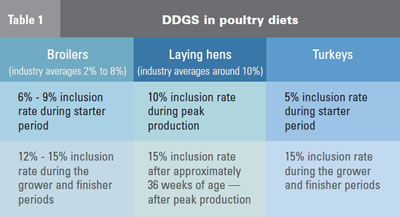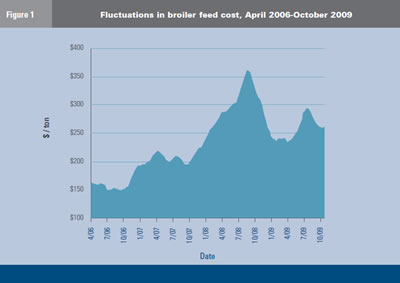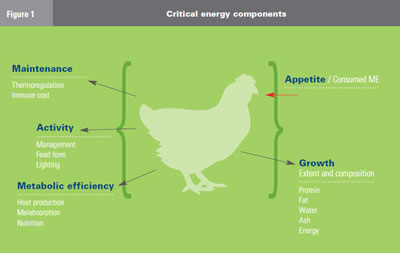 Nutrition Notebook Impact of biofuels on feed poses challenges for producers by Dr Amy BatalAs the poultry business finds its way in the 21st
century, one of the most significant challenges facing
producers is how to respond to the rapidly evolving
biofuels industry.
Biofuels are a relative newcomer in the poultry industry mix, said Dr. Amy Batal, a professor of poultry nutrition at the University of Georgia, Athens. “It’s an immature business, still going through its growth phase, so it’s changing quickly.” When ethanol plants make ethanol, they use only the starch from corn and other grains. The remaining mash contains nutrients such as protein, fiber and oil, which are the byproducts used to make feed for poultry and other animals. These byproducts — dried distillers’ grains with solubles — are commonly known as DDGS. The solubles portion is the liquid that is separated from the mash during processing but then added back in reduced amounts. About one-third of the grain used for ethanol production ends up as DDGS; each bushel produces about 2.7 gallons of ethanol and about 18 pounds of DDGS. Presently, about 6% of the total DDGS produced in the US is fed to poultry, Batal said. Practical DDGS considerations A primary concern with DDGS is product consistency. The amount of solubles added back in to DDGS has a direct impact on nutritional value, Batal said. If too much soluble is added, or it is added too quickly, it can bind up the grain and produce syrup balls, which can lead to loss in energy value. Another factor that affects variability is the quality of grain used to produce the product. Corn from one area of the country may have a significantly different nutritional value than corn from another area. DDGS may vary depending on how the product is processed, such as how long the grain is left to ferment and which enzymes are used to make the product. DDGS color is not generally a reliable indicator of energy value, Batal said. However, color can be a clue to a product’s content of digestible lysine, Batal said. Products with very dark hues tend to have significantly reduced levels of digestible lysine, but moderately hued products usually contain acceptable levels of lysine, she said. Drying is a key factor in lysine availability. Higher temperatures and longer drying times tend to reduce lysine availability. However, it also tends to increase the availability of phosphorus, a vital component. Batal pointed out, however, that DDGS tends to be high in available phosphorus anyway — much higher than corn — which is one of its main benefits. Phytase boosts phosphorus Some growers, Batal continued, are using phytase to enhance the availability of phosphorus in DDGS, and that approach appears to have merit. Sodium content in DDGS is an important factor, and in recent years varying levels in feed have produced problems, Batal told attendees. Sodium is commonly used to clean fermentation tanks, which often leaves residues. In her lab, Batal has evaluated samples with sodium values ranging from less than 0.05% to as high as 0.50%. “That’s a big range,” she said, “and if you don’t monitor that and formulate for the right dose of sodium, you can have problems.” Finding the right mix of DDGS Opinions vary about the optimal inclusion rates for DDGS in poultry feed. That is especially true in broiler production, where DDGS levels vary from 2% to 8%, depending on price and competition with other ingredients. Industry averages for laying hens is more consistent — about 10%. Inclusion rates for turkeys vary from 5% to 15%, with a few growers using as much as 40% DDGS (see Table 1). Receiving and storing DDGS can present challenges, Batal said. An example: If DDGS still hot from processing is loaded directly into trucks or rail cars, it can harden, making it nearly impossible to unload. But Batal said ethanol plants are becoming more aware of that potential snafu and are allowing DDGS to cool before loading. Batal also said it’s important to monitor the moisture content of DDGS, especially during summer months, since levels above 11% can result in mold. New DDG products add other options Ethanol manufacturers are developing new byproducts for the market in an effort to increase their operational profits. Most involve splitting the corn kernel into various components either prior to fermentation or afterwards. Common byproducts, besides DDGS, include food-grade corn oil and bran products that can be burned for energy. Batal stressed that new ethanol byproducts are a rapidly developing market and that many new feed products — with widely varying nutritional content — are likely to appear over the next few years. “It’s important to familiarize yourself with what’s new and to make sure you have accurate nutritional values for anything you consider using,” she said.  Soaring feed prices prompt creative ingredients, processing by Dr. Tom FrostSoaring feed ingredient costs are posing a
predicament for producers and forcing many to
look for alternative ways to provide birds with
the nutrients they need.
“We’ve never faced a cost dilemma to the extent we’re facing one today,” said Dr. Tom Frost, director of nutrition at Wayne Farms in Oakwood, Georgia. Frost pointed out that phosphate rose from $200 per ton in January 2000 to about $1,000 per ton now. Trace minerals rose from $600 per ton to nearly double that currently. Vitamin premixes and poultry fat have doubled in price, and prices for corn and soybeans are up dramatically, too, he said. One key strategy poultry operations are using to combat high prices is increased use of animal byproducts such as meat and bone meal, feather meal and fish meal. Industry data show that poultry operations in the US are using an average of about 4% animal byproducts in their feed; some are using as little as 1.4%, while others are using nearly 11%, Frost said. Although it makes sense to take advantage of animal byproducts if they are of high quality and have been stabilized, adding them to feed formulations usually means a decrease in other components such as deflourinated phosphate, which may have a negative impact on pellet quality, he cautioned. Phytase and NSP enzymes Adding a phytase enzyme can make nutrients in the ration more digestible and help lower phosphate usage, which is favored by environmental regulators, especially in the US, Frost said. Reduced phosphate content can have a negative impact on pellet quality. But on the up side, phosphate is abrasive and including it in feed helps continually polish the stainless steel dies used in milling operations. Substituting other ingredients for phosphate, such as phytase enzymes, can cause a build-up of deposits on the dies, sometimes resulting in flow-through problems, Frost said. He stressed the importance of carefully monitoring flow-through when using phytase enzymes. Non-starch polysaccharide (NSP) enzymes are another feed additive nutritionists are using to combat high costs. Like phytase, NSP enzymes release food energy by making nutrients more bio-available for birds. NSP enzymes vary in nutritional effects, Frost explained, but added that most produce about 40 kcal/lb (88 kcal/kg) in metabolizable energy release. Other potential advantages include cost savings and improvements in pellet quality, if fat is added downstream. Frost said also that when less fat is shipped into the mill it’s easier to monitor quality. Frost cautioned, however, that heat stability can be an issue with NSP enzymes, especially in feed mills with older equipment.  Alternative ingredients
Dried distillers’ grains (DDG) have been used for some time to successfully supplement poultry feeds. Typically they contain 24% to 26% protein, 0.65% lysine, 10% to 12% fat, and from about 0.42% to 0.92% phosphorus, Frost said. At his broiler operation, Frost currently uses about 5% to 7% DDG. He said that formulation saves about US $2 per ton of feed. In the past, he has fed as much as 10% DDG. But he said that when the proportion of DDG reaches that level, it can have a negative impact on pellet quality. Flowability remains an issue with DDG, Frost noted. “If we can’t get DDG off the truck in less than an hour, then it starts to cost us more money than it’s worth,” he said. For that reason, Frost said, “I tend to think really long and hard before I bring DDG into our feed mills.” Wheat is another alternative and it improves pellet quality, Frost said. Wheat prices have fluctuated significantly, Frost pointed out, plus it isn’t always available, at least in the US. Frost said that only underscores the importance of remaining flexible when planning rations. “To take full advantage of prices and availability, you really have to pay attention to the markets and pick and choose different ingredients at different times,” he said. The synthetic amino acid threonine, he noted, has become an increasingly useful ingredient, especially as a protein substitute for pricey soybean meal. Typically, it is fed at a rate of about 0.025% to 0.075% per ton of feed and reduces crude protein content by about 0.50%. What else can be done? Besides adjusting nutritional components of feed, there are other steps producers can take to help manage the high price of feed ingredients. One is paying closer attention to pellet quality, because it affects the amount of time birds spend eating: The higher the pellet quality, the less time and energy birds spend eating and the more time they spend resting and putting on weight. This is especially important with today’s low-energy feeds, Frost said. Conditioning of pellets is another place to look for cost savings, Frost said. He cited a group of studies in which researchers measured the effects of steam-conditioning practices on pellet quality and broiler growth. They showed a dramatic improvement in pellet durability when higher temperatures were used during steam conditioning. That was true regardless of whether conditioning took place at low or high pressure, he said. The amount of time that pellets spend in the conditioner is also crucial to quality, Frost said. Most broiler companies have retention times ranging from 5 seconds to 15 seconds, but some are using much longer times — up to 80 seconds — with good results. To increase retention time in the conditioner, the pitch of mixing paddles in the barrel can be adjusted or the rotational speed of the mixing paddle axle decreased, he said. Frost conceded that increased conditioning costs more, but added, “Those who do allow extra time in the conditioning barrel are going to have better pellet quality.” Management, timing of coccidiosis challenge improves feed utilization by Dr. Robert TeeterLooking for an edge on competitors, integrators
have long sought ways to improve feed efficiency.
But with feed prices continuing to soar, making the
most of rations is not simply a competitive edge —
it’s a matter of business survival.
Besides tweaking feed formulations, integrators are realizing there are other ways to get the most from feed. “It’s easy to put an energy value on a nutritive factor, such as corn, soybean or starch,” said Dr. Robert Teeter, a poultry nutrition researcher at Oklahoma State University, “but other factors, especially energy expenditure, along with many other factors, are also crucial” (see Figure 1). In fact, he said, the amount of heat energy birds expend in their daily activities may be even more important than the actual nutrient value of their diets. Keeping such energy loss to a minimum is vital. Teeter said, “A calorie not expended as heat is money in your pocket.” In lab experiments he conducted, Teeter found that feed-conversion rates for birds raised on the same ration and to the same weights can vary from 1.63 to 2.11, depending on differences in bird behavior that can be manipulated by management changes. For that reason, Teeter and colleagues developed highly sensitive ways to measure what they call “effective caloric value,” or ECV, which is the relative loss of energy — and potential growth — associated with various changes in management that affect bird activity. These include changes in lighting, temperature, ventilation, stocking density and the method by which water is delivered. “Activity regulation offers integrators an avenue for a competitive edge, if they recognize those opportunities and take advantage of them,” Teeter said. Pellets can increase feed value For example, simply pelleting feed instead of feeding mash can reduce bird activity associated with eating and, thereby, significantly increase the effective value of feed calories by about 187 kcal/kg of diet, he said. Research by Teeter and others has shown that improvements gained by pelleting are greatest in the latter part of the growth cycle, when birds are consuming the most feed. Lighting programs, too, can be used to increase the ECV of feed, Teeter explained. In one series of studies, he compared the effects on ECV of two lighting programs: 23 hours light/1 hour dark compared to 12 hours dark/12 hours light. Birds in the 23/1 lighting environment consumed about 3,250 kcal/kg to reach market weight, while birds in the 12/12 environment used only 3,100 kcal/kg to attain the same weight — a savings of 150 kcal. As Teeter pointed out, instead of increasing the caloric density of the diet to improve FCR, a grower could choose to use reduced periods of lighting to get the same level of performance. Similar kinds of performance gains can be attained by manipulating the ambient temperature in which birds are raised, Teeter said.  Controlling the timing of coccidiosis challenge
One of the most significant improvements in ECV can be gained by effectively controlling the timing of coccidiosis challenge, he continued. While it is true that optimal performance would be achieved in an environment completely free of coccidia, it’s unrealistic to expect such conditions in the field, given the limitations of currently available anticoccidials. So for years, integrators have been accepting low-level coccidiosis and its associated loss in FCR as a normal part of using ionophores to grow broilers. However, the impact on ECV of even low-level coccidiosis can vary dramatically depending on the age at which challenge occurs, Teeter said. In a series of studies, the researcher and his group challenged birds at various points in their life cycle with an orally administered solution containing three common species of Eimeria, the parasite that causes coccidiosis. After challenge, Teeter monitored the birds closely, recording changes in factors such as heat production, live weight, retained energy and composition of excreta. After 6 days, the birds were necropsied and their coccidial lesions scored. Compared with controls that received no coccidial challenge, the birds with coccidial lesions scored lower in live weight and average daily gain, and had poorer FCR. As the size of lesions increased, so did the negative effects on growth and feed conversion. But what was most significant, Teeter emphasized, was that late in life even minor coccidial lesions exacted a significant toll. “In the grower-finisher phases, the consequence of lesions was markedly elevated, and the closer we got to the end of the growth curve, the more significant the consequences,” he said. Real-world significance The findings have important real-world significance. In birds grown on a 48-day schedule, for example, about half the total consumption of food occurs during the final 2 weeks, he said. If birds are stressed with coccidiosis lesions during that time, it reduces appetite, elevates maintenance costs, increases malabsorption of nutrients and, therefore, cuts into the ECV of feeds. “Unfortunately, though, birds [with coccidial lesions] don’t reduce their appetites to the complete degree that would eliminate feed loss; they continue to eat and continue to consume profits,” he said. In contrast, his and other studies have shown that early exposure to coccidiosis — such as occurs in birds vaccinated at 1 day of age against coccidiosis — has only a minor negative effect on those same variables. Birds have sufficient time after early challenge to make up for lost performance resulting from exposure, whereas later the consequences are much greater, he said. Like other management decisions, such as lighting and temperature changes or pelleting versus mashed feeds, the timing of coccidial challenge is a crucial variable that can be manipulated to advantage, and it should be considered in formulating any management strategy, he stressed. “It’s very important to understand the effects of coccidiosis challenge and to avoid these lesions, especially late in the growth cycle, since they significantly reduce flock profitability,” Teeter said. Subclinical coccidiosis is increasing; consequences can be substantialBroiler producers who think they don’t have
subclinical coccidiosis or that the disease isn’t
having a significant impact on their bottom line
should reconsider, advises an independent
poultry nutritionist.
Covert subclinical coccidiosis is “much, much more common than an outright coccidiosis outbreak, and has been growing slowly in incidence in recent years due to increasing resistance to in-feed anticoccidials, particularly the ionophores,” says Dr. Phillip Hargis of Batesville, Arkansas. Unfortunately, many broiler companies don’t recognize it or just ignore subclinical coccidiosis, “but the disease does impact performance, requiring a slight increase in vitamins and trace minerals. It does impact skin integrity and the immune system slightly,” he says. These are subtle changes, but the price to producers can be substantial. “It’s costing most of us four, five or more points of feed conversion,” Hargis says. When broiler-house costs were more reasonable, keeping birds a day or two longer in the field didn’t make much difference. But with rising costs, “we have to get more birds through the house so the grower can pay his mortgage and make a living or we have to increase contract pay,” Hargis continues. Pushing birds through a house with subclinical coccidioisis, however, is expensive. “Feed conversion lost to subclinical coccidiosis now costs us $15,000 a point today, versus $3,500 yesterday. And never mind the fact that drug costs are increasing. So we are paying more for drugs that are failing more, and we have more feed costs per pound of meat, while we’re paying growers more contract pay. Do you think that’s a good plan?” Hargis asks. Resistance to in-feed anticoccidials has resulted from their overuse. “Eventually all drugs lose some of their power and may even refuse to work at all,” he says. Several anticoccidial chemicals are no longer available, which has reduced the number of in-feed options. When a coccidiosis break occurs, an anticoccidial may be removed from the rotation, putting even more pressure on remaining anticoccidials. Understand oocyst leakage Coccidial oocyst leakage is another subject that Hargis says is important for understanding resistance and subclinical coccidiosis. About 65% to 70% of all broilers produced in the US have been raised on anticoccidial-drug programs that result in oocyst leakage into the broiler house. Producers tell him that oocyst leakage is “just like using a coccidial vaccine,” but there’s a huge difference, he emphasizes. Oocyst leakage that occurs with an anticoccidial- drug program loads the house with oocysts that are resistant to the drug itself. In contrast, coccidiosis vaccines seed the house with strains of coccidia that are still sensitive to anticoccidials, which extends the life of anticoccidial drugs, he says. If producers are to control subclinical coccidiosis and the problems it causes, they first need to look for the disease. Visual posting “doesn’t tell the story,” so schedule microscopic posting sessions, which are provided by the manufacturers of coccidiosis-control programs, Hargis says. Another way to tell if subclinical coccidiosis is present is if there’s a big improvement in feed conversion after switching from an ionophore to an anticoccidial chemical. “We’ve seen a 10-point improvement in feed conversion” after such a switch, although the chemical may also wear out after a few cycles, he says. A similar improvement may be seen after switching from in-feed anticoccidials to a coccidiosis vaccine. After a few vaccine cycles, he says, “we’ve been amazed that for the first time, broiler performance with a vaccine was actually better than the drug program.” It was once assumed that coccidiosis vaccines hinder feed conversion and growth rate, but not any more. “Many times today, it is a huge benefit to go to a coccidiosis vaccine,” Hargis says. Check program efficacy Whether using anticoccidials or a vaccine, the coccidiosis-control program should be checked roughly 5 weeks after starting and 5 weeks after each turn of the program, Hargis says. If using anticoccidials, rotate drugs three times yearly, using the strongest drug starting in January, and use a coccidiosis vaccine for at least 6 months out of every 24-month period to combat anticoccidial resistance, he recommends. One of the common denominators Hargis sees on farms with subclinical coccidiosis, he notes, is a lack of resolve to change a drug program that is working well, which “may fix the present but mess up tomorrow.” His advice to include a coccidiosis vaccine in the rotation applies regardless of bird size, because smaller birds can do well with a coccidiosis vaccine if fed proper nutrition. Coccidiosis vaccines do not have to be rotated because resistance with them is not an issue, nor does their use need to be limited to any particular kind of environment as long as birds are fed correctly. Broiler performance improves the longer a vaccine is used, up until 12 months, and then levels out for the duration, Hargis says. Management practices are just as important in controlling subclinical coccidiosis, he adds. Litter should be of proper depth and moisture. Birds also need proper nourishment to support the gut, enabling it to recover from coccidial cycling. Remember, Hargis says, “there is never a flock of broilers of any type that benefits from subclinical coccidiosis.” Regresar a North American Edition (#3) |




 © 2000 - 2021. Global Ag MediaNinguna parte de este sitio puede ser reproducida sin previa autorización.
© 2000 - 2021. Global Ag MediaNinguna parte de este sitio puede ser reproducida sin previa autorización.